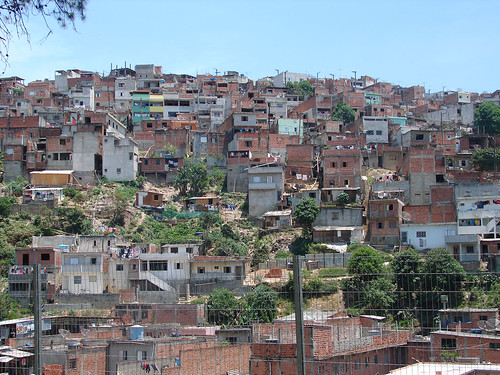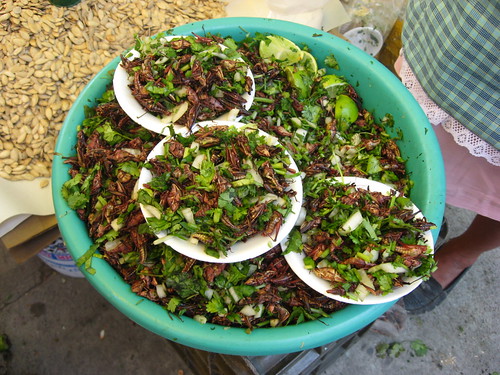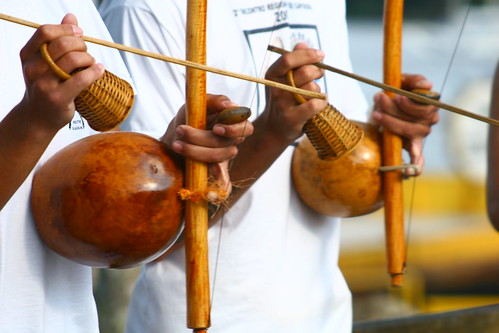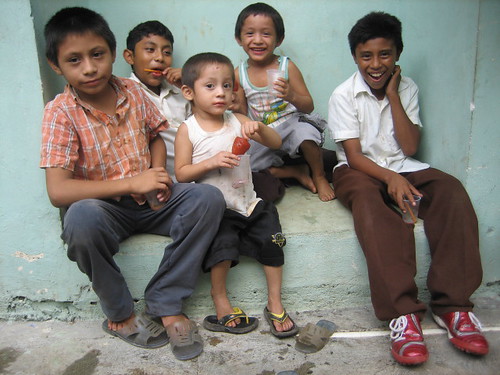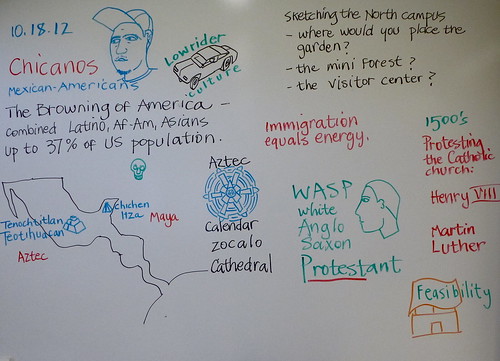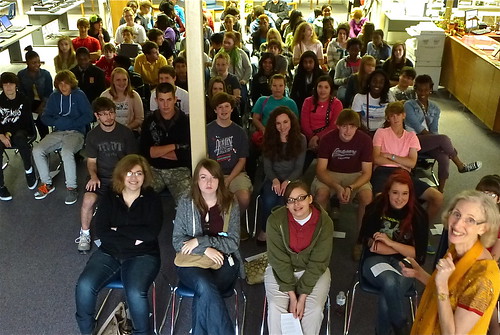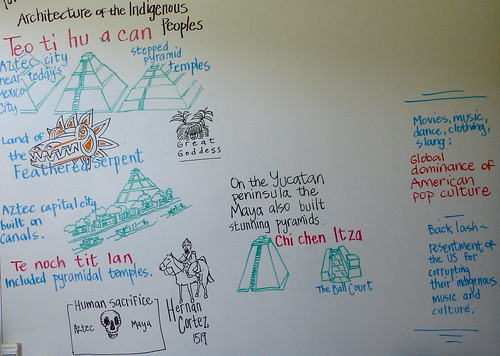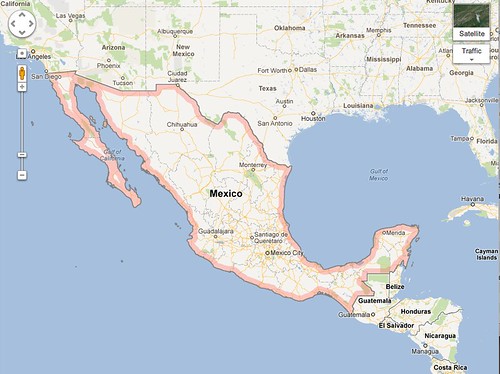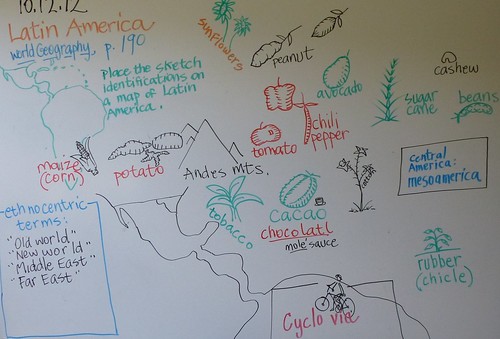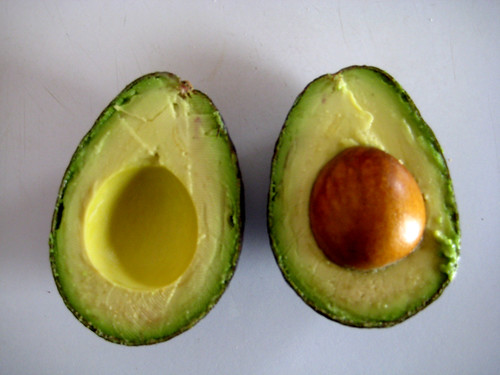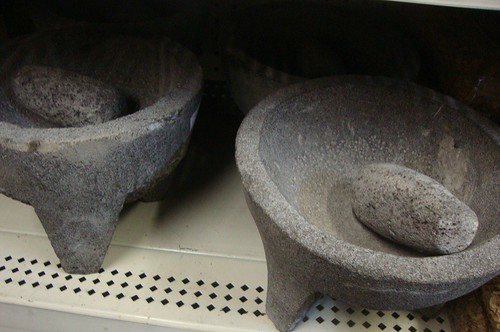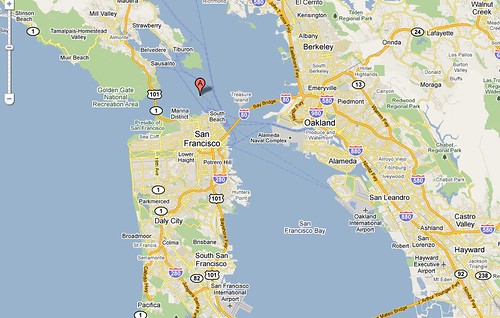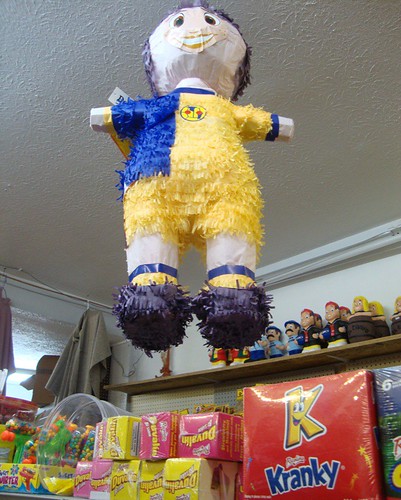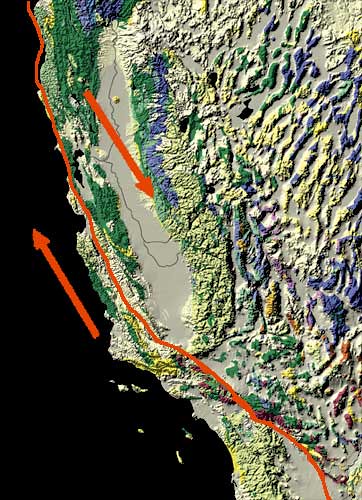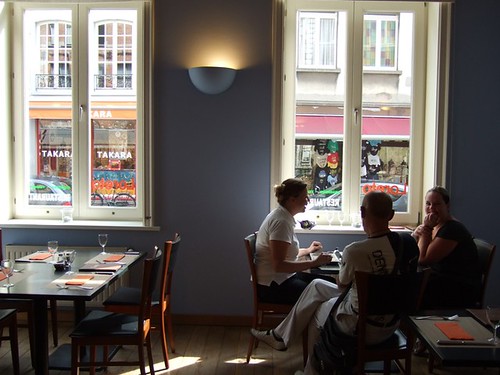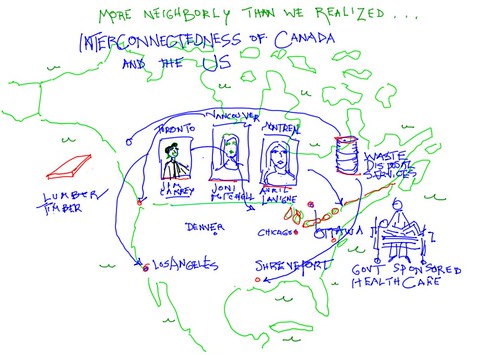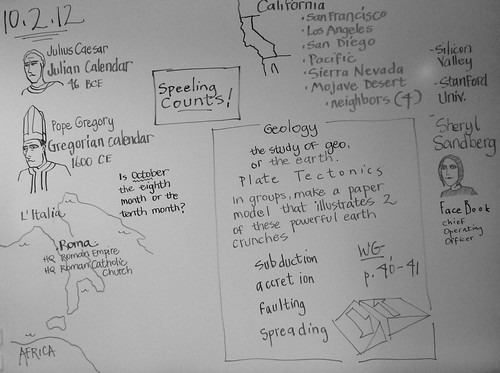A hybrid of Aztec and Catholic rituals, Dia de los Muertos is based on ancestor worship.
Notes on Dia -
- Celebrated on Nov 1, All Saints Day, Nov 2, All Souls Day in the Catholic Church.
- Partying in the cemeteries. Food, drink and talking with long-time friends.
- Pan de Muertos.
- Tequila: distilled from the Blue Agave cactus.
- Candles and marigolds. Sometimes Monarch butterflies.
- Papel Picado: symmetric and figurative scenes cut in tissue paper.
- Ofrendas (offering); an altar laden with food, drink and mementoes dedicated to a beloved ancestor.
- Calacas: skulls.
- Calaveras: skeletons - often clad in items suggestive of people in all occupations.
- Catrina: female, well-to-do skeleton.
- Pagan: pre-Christian worship.
Anatomy of a skeleton's bones.
- cranium
- mandible
- vertebrae
- clavicle
- sternum
- scapula
- rib cage
- humerus
- radius and ulna
- carpal bones
- metacarpals
- phalanges
- pelvic girdle
- coccyx
- femur
- patella
- fibula and tibia
- tarsal bones
- metatarsals
- phalanges
Wednesday, October 31, 2012
Mexican celebration that is spreading across the US: Dia de los Muertos
Sunday, October 28, 2012
German corporation, Benteler Steel Tube, to build Shreveport manufacturing facilities in 2013
By establishing a production site in the U.S.A. Benteler Steel/Tube GmbH will strengthen its presence in one of the most important growth markets for global oil- and gas-exploration, says Benteler.com.
With the growing demand for highquality steel tubes for exploratory drilling in the U.S., and Louisiana’s proximity and access to energy customers, Benteler Steel/Tube’s Louisiana plant is poised to play an important role in meeting U.S. domestic energy needs.
The total investment (in 2 facilities) will be nearly $ 900 million. Both plants will create an estimated 675 full time jobs when at full capacity.
Privately held and family owned in the fourth generation the company is
proud of its more than 135-year history of success. The Benteler Group employs 30,000 employees at 170 locations in 38 countries.
Lap Height More: The Five (5) Themes of Geography
Were you taught the 5 themes of geography? If not, let us dig in.
One sketch, one theme per page in your notebook.
1. Location
Most geographic study begins with learning the location of places.
Location can be
- absolute (2511 Filbert) or
- relative (South Bossier Parish).
Absolute location provides a definite reference to locate a place. Like 32N, 94W. The reference can be latitude and longitude or a street address: 1601 Viking Dr, 71101.
Relative location describes a place with respect to its environment and its connection to other places. "Near the town of Belcher, west of the Red River."
2. Place
Place describes the human and physical characteristics of a location.
Physical characteristics include a description such things as the mountains, rivers, beaches, topography, and animal and plant life of a place.
- For instance, we can say that Shreveport lies in the Muscadine-Raccoon Belt.
- Rolling hills and bayous.
- Iron-ore rich, red clay dirt region.
Human characteristics include the human-designed cultural features of a place, from land use and architecture to forms of livelihood and religion to food and folk ways to transportation and communication networks.
- The Bible Belt.
- The Black-eyed peas and peach cobbler Soul Food region.
- The Shotgun Shack region.
3. Human-Environment Interaction
This theme considers how humans adapt to and modify the environment. Humans shape the landscape through their interaction with the land; this has both positive and negative effects on the environment.
- The intersection of i-20 and i-49.
- The former lands of the Caddo.
4. Movement
Humans move, a lot! In addition, ideas, fads, goods, resources, and communication all travel distances. This theme studies movement and migration across the planet.
- Site of a German steel tube manufacturing plant to be complete in 2013.
- Former site of a GM manufacturing plant.
- Concert site: the Centurylink Center.
- Gateway to Louisiana's Carnival.
5. Region
Region divides the world into manageable units for geographic study. Regions have some sort of characteristic that unifies the area. Regions can be formal, functional, or vernacular.
Formal regions are those that are designated by official boundaries, such as cities, states, counties, and countries. For the most part, they are clearly indicated and publicly known.
- Caddo Parish.
- Shreveport, La.
Functional regions are defined by their connections. For example, the circulation area for a major city area is the functional region of that paper.
- Metropolitan Shreveport includes Bossier City.
- ArkLaTex.
Vernacular regions are perceived regions, such as "The South," "The Midwest," or the "Middle East;" they have no formal boundaries but are understood in our mental maps of the world.
- Ratchet City.
- North Louisiana.
Wednesday, October 24, 2012
Metro populations in South America
Metropolitan populations - city plus suburbs - in South America:
1 São Paulo, Brazil 20,831,058
2 Buenos Aires, Argentina 14,598,065
3 Rio de Janeiro, Brazil 12,128,429
4 Bogotá, Colombia 8,423,837
5 Lima, Peru 8,000,111
6 Belo Horizonte, Brazil 5,731,826
7 Santiago, Chile 5,196,846
8 Caracas, Venezuela 4,478,851
9 Porto Alegre, Brazil 4,076,158
10 Salvador, Brazil 3,904,528
11 Recife, Brazil 3,843,250
12 Curitiba, Brazil 3,571,695
13 Fortaleza, Brazil 3,511,954
Mexico City snacks: chapulines, or toasted grasshoppers
Chapulines, plural for chapulín, are grasshoppers of the genus Sphenarium, that are commonly eaten in certain areas of Mexico, says Wikipedia.
The term is specific to Mexico and derives from the Nahuatl word chapolin.
They are collected and after being thoroughly cleaned and washed, they are toasted on a comal (clay cooking surface) with garlic, lime juice and salt containing extract of agave worms, lending a sour-spicy-salty taste to the finished product.
Tuesday, October 23, 2012
Quiz on the Americas, from Mexico to Brasil
From Tijuana to Sao Paulo
1. Ethnocentric terms include Old World and Middle East. T / F
2. Peanuts, pecans and potatoes were indigenous to Mesoamerica. T / F
3. The bean known as __ traveled from the Arabian peninsula to Europe to Mesoamerica.
4. Sugarcane was a crop indigenous to __ . a) Mesoamerica b) Asia c) Africa d) Europe.
5. Indigenous peoples in the Americas were decimated by disease following incursion by the a) slavers b) Africans c) aliens d) Europeans.
6. The Aztecs built cities and giant pyramids at Teotihuacan and Chichen Itza in central Mexico. T / F
7. The Aztec and Maya religious duty of __ __ was abhorrent to the Spanish.
8. The victorious leader of the Spanish conquistadores in the war with the Aztec was __ . a) Montezuma b) Cortez c) Avocado d) Zocalo.
9. It is a historic object of 24 tons that demonstrates high achievement in geometry and physics; it is the __ developed by Aztec astronomers.
10. Population growth by __ Americans represented the highest rate of ethnic increase.
11. US population: 72% __ . a) White b) African-American c) Latino d) Asian.
12. US population: 13% __ . a) White b) African-American c) Latino d) Asian.
13. US population total is approximately __ million.
14. The largest Brazilian cities are a) Sao Paulo and b) Rio de Janeiro. The metropolitan population of __ is about 11 million as opposed to the 6 million of the other city.
15. The national language of Brasil is not Spanish or English; it is __ . Must be spelled correctly.
16. Brasil's culture is famous for a nation-wide focus on futbol and __ . a) capoeira b) samba c) drumming, or percussion d) manufacturing.
17. Above is an instrument composed of string and stick, rock, gourd, shaker and stickette.
It is used to accompany the African martial arts-based dance called a) capoeira b) samba c) quilombo d) berimbau.
Monday, October 22, 2012
"Bom dia!" an intro to Brasil
Land of a distinct culture:
- Samba music and dance
- the most highly-regarded futbol players
- an Afro-Cuban society.
- Portuguese arrived about 1500.
- African slaves imported because indigenous people decimated by disease.
- Slave ships. Rebellion on the La Amistad.
- Neighbors: Venezuela, Guyana, Suriname, French Guiana; Colombia, Bolivia, Peru, Argentina, Paraguay and Uruguay.
- 44% Brown (multiracial) or Pardo, 48% White, 7% Black.
- Sao Paulo: 11M
- Rio de Janeiro: 6M
- Portuguese language.
- Samba is dance, is music, is culture.
- Samba Schools - music club that parades at fests and esp at Carnaval.
- Bateria: orchestra of drums, incl. Surdo de primera, surdo de segunda, surdo de terceira, caixa de guerra, repinique, chocalho, tambourim, cuíca, agogô, reco-reco, and frigedeira.
- Berimbau: string and gourd instrument - w shaker - for capoeira.
- Capoeira: martial arts dance from African and indigenous sources.
- Quilombo: escaped slaves encampment - sometimes a town or even a city.
- Practice of capoeira outlawed after slave emancipation, 1888. Illegal until 1940.
- Carnaval: basically, the country stops completely for almost a week and festivities are intense, day and night, mainly in coastal cities.[2]
- Feijoada is a stew of beans with beef and pork, which is a typical dish in Portuguese and Brazilian cuisine. It is considered the national dish.[2]
The impoverished nation of Mexico: type 3 multiple-choice questions for next class
For Wed: three mult-choice questions on the Land of the Feathered Serpent.
- colorful title.
- base the questions on notes.
- make them challenging.
- answers at page bottom.
12 pts. Grammar, speeling, etc.
Thursday, October 18, 2012
Chicanos and the Browning of the US
Currently, population growth is fastest among minorities as a whole, says Wikipedia, and according to the Census Bureau's estimation for 2012, 50.4% of American children under the age of 1 belonged to minority groups.[19]
Hispanic and Latino Americans accounted for almost half (1.4 million) of the national population growth of 2.9 million between July 1, 2005, and July 1, 2006.[20] Immigrants and their U.S.-born descendants are expected to provide most of the U.S. population gains in the decades ahead.[21]
The approximate 2010 breakdown is White, 72.%, Af-Am, 12.6%, Asians, 4.8%, Hispanic or Latino, 16.4%.
The US Census report foresees the Hispanic or Latino population rising from 16% today to 30% by 2050, the African American percentage barely rising from 12.9% to 13.0%, and Asian Americans upping their 4.6% share to 7.8%.
The U.S. has 310 million people as of October 2010, and is projected to reach 400 million by 2039 and 439 million in 2050.[22][63][64][65] It is further projected that 82% of the increase in population from 2005 to 2050 will be due to immigrants and their children.[66]
Teen crime in Shreveport trending downward, says Judge Matlock in KTBS report
Teen crime in Caddo Parish just isn't what it used to be, says KTBS News.
Chief Judge David Matlock says the number of teens entering the Caddo Juvenile Court System has lowered. He says major juvenile crimes saw a 25 percent decrease from 2001 to 2011. Matlock says years worth of effort from local government and communities has led to the decrease.
"It's taken a lot of leadership, a lot of teamwork, a lot of hard programming," Matlock said.
The juvenile justice system has 126 rehabilitation programs used to get kids into check. Matlock says each child is assessed and appointed to one that best suits their needs. The goal is to aggressively attack their problems early.
"So, when we see a child with a reasonably serious situation coming in at a fairly young age, that's a red flag for us to get involved," he said.
Matlock says truancies, which have lowered in Caddo Parish, are a major sign of a future problem. Those kids entering the parish's rehabilitation programs may face good odds. Matlock claims high success rates.
"80 percent success rates with a lot of these early intervention and mid-intervention programs, and those are extremely good success rates," he said.
To give you an idea of the decrease, Matlock says juvenile detention admissions are down 40 percent. Auto theft cases are down 88 percent, that's from 1994 to 2011.
Copyright 2012 KTBS. All rights reserved
Tuesday, October 16, 2012
Aztec Calendar stone or Sun stone, National Museum of Anthopology, Mexico City
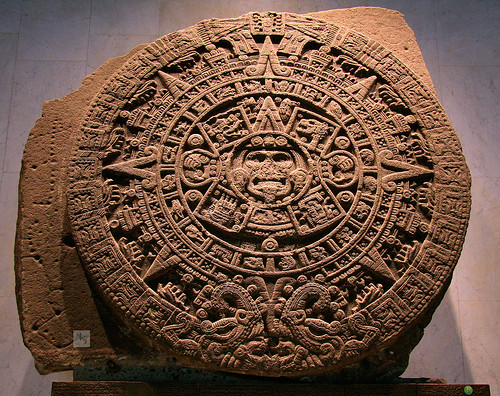
Aztec Calendar stone or Sun stone, National museum of Anthopology, Mexico City, a photo by Mikey Stephens on Flickr.
The Aztec calendar is a system that was used by the Aztecs as well as other Pre-Columbian peoples of central Mexico, such as the Maya.
The calendar offered of a 365-day calendar cycle.
The Aztec calendar stone, Mexica sun stone, Stone of the Sun (Spanish: Piedra del Sol), is a monolithic sculpture that was excavated in the Zócalo, Mexico City's main square in 1790.[2] It was discovered whilst Mexico City Cathedral was being repaired.[3]
The stone is around 12 feet (3.7 m) across and weighs about 24 tons.[4]
The Aztec knowledge of geometry enabled them to carve the stone symmetrically and their knowledge of mechanics enabled them to move the stone from its quarry to its final destination.[1]
The figure in the center may be the sun god or sea god.
There is little left of Aztec history. "The codices that documented the events of Spanish contact repeatedly describe the demand by the Spaniards for the Aztecs to end the human sacrifices that were committed before their eyes. The Aztecs routinely refused despite these pleas," says worldmuseumofman.org.
"What the Spaniards saw in the Aztec society was beyond anything they could have ever seen in their former experiences. Because of this, the destruction of all traces of Aztec society by Cortes and his army was complete. Aztec artifacts are amongst the rarest of Mesoamerican Indian cultures because little survived their annihilation."
Deborah Morehead, clad in salwar kameez, presents a journey to the villages of impoverished India
Descriptive essay on Deborah Morehead's India presentation:
- Open with pure description of a scene, event or activity seen in the presentation.
- Do not use the traditional "I learned quite a lot about poverty in India ..."
- Use 3rd person.
- Describe 2 incidents.
- End with "according to teacher Deborah Morehead."
- Add a colorful title.
- 10 pts.
- Grammar and speeling.
Monday, October 15, 2012
Aztecs and Mayas created amazing monuments
Aztecs, in the central Mexican uplands, and the Maya, on the plains of the Yucatan peninsula, both built pyramids and practiced human sacrifice.
Gulf coast neighbors: Mexico and Louisiana
Tampico and Popocatepetl
1. The US states that border Mexico: California, Arizona, __ __ and Texas.
2. The Yucatan Peninsula is closest to a) Texas b) Cuba c) Florida d) Jamaica.
3. Mexico has a Pacific coast and a Gulf of Mexico coast. Regrettably, it lacks a Caribbean coast. T / F
4. West and slightly north of the capital is the second largest Mexican city: ___ .
5. Mexico is part of Central America, a region called __ ("middle America") by archaeologists and historians.
6. The takeover of Mexico by Spanish conquistadors was made easier by the decimation of the population via ___ .
7. People from Europe discovered new food plants in Central America. One was the tomato. T / F
8. One of the plants discovered by Europeans was a powerful spice that also had medicinal effects. It was the __ __ .
9. This starchy plant was developed in the Andes Mountains of Peru and Ecuador. It was the a) potato b) avocado c) cacao bean d) peanut.
10. Trumpets, fiddles, guitars and harmonized vocals are typical of the Mexican folk music called __ .
Sunday, October 14, 2012
Columbian exchange: cashews, cacao beans, chicle, but not sugar cane
Explorers returned to Europe with maize, potatoes, and tomatoes, which became very important crops in Eurasia by the 18th century, says Wikipedia.
The Columbian Exchange also brought disease. "It is estimated that upwards of 80–95 percent of the Native American population was decimated within the first 100–150 years following 1492; the most affected regions in the Americas lost 100% of their population," says Wikipedia.
- The horse - the mustang - was brought to the Americas by the Spanish.
- Sugar cane arrived from China via Europe.
- Coffee journeyed from Arabia to Europe to the New World.
- Oranges migrated from Southeast Asia.
Terms that are biased - ethnocentric - and that should be replaced by descriptive terms:
- Old World (they were both "old")
- New World
- Middle East
- Far East (coined by the British).
Friday, October 12, 2012
Avocados, cashews, chocolatl and the Columbian Exchange
In 1492, Christopher Columbus' first voyage launched an era of large-scale contact between the Old and the New World that resulted in this ecological revolution; hence the name "Columbian" Exchange.
As an example, the plants that originated in the New World include:
avocado
beans
cashew
chia
chicle (chewing gum base)
chili pepper (includes the bell pepper)
cocoa / chocolate
cotton (long staple variety, 90% of modern cultivation)
maize (corn)
papaya
peanut
pecan
pineapple
potato
rubber
squash (incl. pumpkin)
sunflower
strawberry (American species used in modern hybrids)
sweet potato
tobacco
tomato
vanilla
The Columbian Exchange has been one of the most significant events in the history of world ecology, agriculture, and culture, says Wikipedia.
One example from the New World:
Christopher Columbus was one of the first Europeans to encounter chili peppers - in the Caribbean, He called them "peppers" because of their similarity in taste (though not in appearance) with the Old World peppers of the Piper genus.
Chilies were cultivated around the globe after Columbus' time.[4][5] Diego Álvarez Chanca, a physician on Columbus' second voyage to the West Indies in 1493, brought the first chili peppers to Spain, and first wrote about their medicinal effects in 1494.
From Mexico, at the time the Spanish colony that controlled commerce with Asia, chili peppers spread rapidly into the Philippines and then to India, China, Korea and Japan with the aid of European sailors.
Thursday, October 11, 2012
Assignment: brief presentations Oct 15-16 on a Latin American nation ofyour choice
Powerpoint-type presentation, 15 pts.
- 5 colorful images of the nation plus a map.
- very brief notes atop each image.
- documentation.
- clever title.
- On an additional image present 3 multiple-choice questions which review your important points. Make 2 of them easy and one challenging.
- due Mon-Tues. We will make all presentations on that day using alpha order.
- Solo project.
- Choose a nation from Central America or South America.
The image above -
A metate is a mortar, says Wikipedia. It is a ground stone tool used for processing grain and seeds.
In traditional Mesoamerican culture, metates were typically used by women who would grind calcified maize and other organic materials to make tortillas.
Similar artifacts are found all over the world,[1] including China.[2]
Tuesday, October 09, 2012
Geography and American affluence
The economic map of America today does not show just one country - it shows three increasingly different countries.
At one extreme are America’s brain hubs – cities like Seattle, Raleigh-Durham, Austin, Boston, New York and Washington DC – with a thriving innovation-driven economy and a labor force among the most creative and best paid on the planet, says Enrico Moretti.
The most striking example is San Francisco, where the labor market for tech workers is the strongest it has been in a decade.
At the other extreme are cities once dominated by traditional manufacturing – Detroit, Flint, Cleveland – with shrinking labor force and salaries.
In the middle there is the rest of America, apparently undecided on which direction to take.
Comparing the relatively affluent Canada to the relatively impoverishedMexico
In this geography class the basics elements in a national comparison are . . .
- population
- PCI, or per capita income (per person)
- Educational attainment
- Employment level
- Life expectancy
Please include this source in your search.
Monday, October 08, 2012
Create an Online Portfolio; keep a record of achievements and get end-of-semester indie points
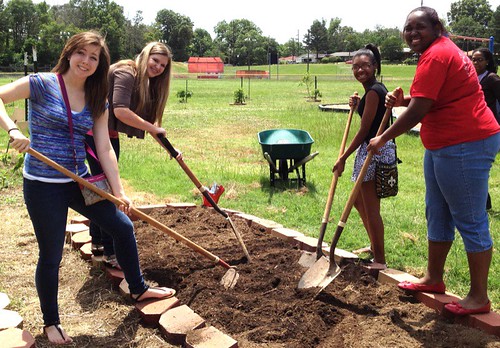
Caddo Magnet HS students / Valencia Communty Garden / photo Keri Stevenson, a photo by trudeau on Flickr.
Establish an Online Portfolio using a social networking site or photo collection site such as flickr.com.
This will be a record of your best projects, papers, activities, whether in school or away from school.
Scan or photograph papers and projects. See example of an activity photo above.
Useful for applications to camps, internships, grants, special summer programs, employers and, eventually, colleges.
Up to 10 pts at end of semester indie credit for no less than 10 images.
Pacific-oriented geology quiz
Geology quiz
1. The Appalachian range is an example of a) subduction b) faulting c) accretion d) spreading.
2. Geologists report in National Geographic magazine that the distance between North America and Europe is increasing each year by about 2.2 inches. That is an example of a) subduction b) faulting c) accretion d) spreading.
3. The Coast Range runs along the Pacific coast in California. They are small but craggy mountains. They are so close to the ocean shore that they seem to rise magically from the surf. They would be an example of a) subduction b) faulting c) accretion d) spreading.
4. The San Andreas Fault is a crack in the earth's plates that threatens the California rim with a devastating earthquake. It is an example of (be careful!): a) subduction b) faulting c) accretion d) spreading.
5. Write the coordinates for San Francisco. __ N, __ W.
6. Name the exciting Canadian city on the Pacific coast. Known for its fabulous aqaurium, vibrant Asian population and high-tech achievements, it is a city similar in size to Denver.
It is __ .
7. One of Facebook's chief officers is a woman known for encouraging females to enter the world of Silicon Valley-type businesses. She is Sheryl __ .
Sunday, October 07, 2012
Social Studies Fair Project based upon the scientific method: deadline for paper Fri, Oct 26
Not due as a paper until Fri, Oct 26, the social studies fair project is perhaps best handled as a collaborative effort. Up to 4 students may work together.
The goal for my class is to demonstrate competence in the scientific method. The essential steps are -
- Question / problem
- hypothesis
- gathering of evidence
- conclusion
- bibliography.
I am interested in a paper that demonstrates the ability to gather evidence from no fewer than 4 sources. There should be at least 1. a book source. 2. two articles.
3. an interview.
The principle evidence gathering will take place via a review of the literature. Experiments are not required.
To protect students when working in groups, I will expect a section that reports the division of work. Let's say that Larry Moncrief researched and wrote all of the evidence gathering section, and Mary Bishop contributed only the hypothesis and the conclusion and Will Slaughter contributed only 6 photos. I think that I would need to inquire as to whether one student might get a higher score than the other 3 based on time and responsibility.
Project Topics and Disciplines
Anthropology: Ancient civilizations, Native Americans, customs, festivals, types of shelter and food, religion, etc.
Economics: Money, manufacturing, trade, transportation of goods and services, communication, inflation, stock exchange, common market, government budgets, etc.
Geography: Ecology, foreign countries, lands and people, maps, flooding, rivers, lakes, cities, conservation, etc.
History: Story of mankind, historical events, places, biographies, personalities, wars, etc.
Political Science: Government agencies, FBI, crime, U.S. Constitution, courts system, international governments, etc.
Sociology: Families, crime, mental health, propaganda, life styles, dreams, television, media, etc.
In considering a topic these things should be kept in mind:
1. Value- -The topic should she light on some significant aspect of human experience.
2. Originality- - If a project has been the subject of a previous investigation, the proposed new study should either furnish substantial new evidence or provide a significant new interpretation.
3. Practicality- - Sources must be available which one may use conveniently and without fear of censorship. The scope of the subject should be neither too limited nor too broad.
4. Unity- - Every project must have a unifying theme, or be directed to a certain question or thesis, so that there is a point of departure, the development of the subject, and specific conclusions.
This post has been on the class blog since Aug 23.
Friday, October 05, 2012
Cirque du Soleil: a world-class creation from Quebec and Montreal
Cirque du Soleil ("Circus of the Sun") is a Canadian entertainment company, says Wikipedia; it is self-described as a "dramatic mix of circus arts and street entertainment."
Based in Montreal, Quebec, Canada, and located in the inner-city area of Saint-Michel, it was founded in 1984 by two former street performers, Guy Laliberté and Gilles Ste-Croix.[2]
To this day it is operated by French Canadians.
The numerous Cirque shows employ approximately 4,000 people from over 40 countries and generate an estimated annual revenue exceeding US$810 million.[6][7]
The multiple permanent Las Vegas shows alone play to more than 9,000 people a night, 5% of the city's visitors, adding to the 90 million people who have experienced Cirque worldwide.
Please see videos of their performances.
canada: important neighbor
Vancouver to Quebec, a Canada quiz & answers
Buddy Flett & Hubert Sumlin in NYC
Originally uploaded by trudeau
It's a quiz, eh!
T 1. Canada’s population is about one tenth of the US population, although it is slightly larger than the US in area. T / F
A 2. An island in Eastern Canada came under British rule with the Treaty of Utrecht (1713). This resulted in a serious change in the population of a) Nova Scotia b) Quebec c) Massachusetts
d) Montreal.
B 3. Canadians often speak 2 languages, owing to their nation’s ethnicity: a) English & German b) English & French c) English & Inuit d) English & Canadianne.
B 4. Born and raised in Montreal: a) Michael Cera
b) Sieur d’Iberville c) Beausoleil d) Celine Dion.
A 5. The French who were born in Louisiana colony were called a) Creoles b) Acadiennes c) Cajuns d) Gumbo.
D 6. Between their impoverished life in Western France and their impoverished life as pioneers in Louisiana, the French colonists spent about 150 years in a) the Caribbean b) British Columbia c) Toronto d) Acadia.
B 7. Guy Laliberté and Daniel Gauthier founded a) Canadian Waste Disposals Systems b) Cirque de Soleil c) the rock band Rush d) Quebec City.
C 8. The nation’s capital: a) Quebec b) Montreal c) Ottowa
d) Toronto.
D 9. The Great Lakes connect to the Atlantic via the
a) Illinois-Michigan Canal b) Erie Canal c) Niagra Falls
d) St Lawrence River.
T 10. Part of Canada is an archipelago. T / F
B 11. “Canada is also geologically active, having many earthquakes and potentially active volcanoes,” says Wikipedia. This would refer to __ Canada. a) Eastern b) Western c) Northern d) Southern
D 12. The coordinates are 45N, 73W: a) Toronto b) Winnipeg c) Detroit d) Montreal.
B 13. Land area: which is larger, the a) US or b) Canada?
Thursday, October 04, 2012
California: the coast and Silicon Valley
The Golden State quiz
1. Along the Pacific coast, Oregon through California, find the mountains called Coast Range. They are __ to the Sierra Nevada range. a) parallel to b) perpendicular to c) pretty close, but not what you would call too close.
2. Because the Coast Range mountains are low in height and very, very close to the Pacific shore, we can say they represent an example of a) subduction b) faulting c) spreading d) accretion.
3. The Sierra Nevada Range would be an example of a) subduction b) faulting c) spreading d) accretion.
4. The ___ National Park is immediately east of San Francisco. a) Yellowstone b) Navajo c) Yosemite d) Grand Canyon.
5. North of Los Angeles is the __ National Park. It is named for the giant redwood trees of California.
6. The name of the Mexican peninsula that lies to the south of California: __ California.
7. The map coordinates for Los Angeles.
8. Close to San Francisco you will find Palo Alto, the home of Stanford University, one of the world's top academic institutions. There is a business-oriented regional name that can be applied to the area around San Jose and Palo Alto. It is referred to as __ __ .
9. The San Andreas Fault extends well north of San Francisco. T / F
1a2d3a4c5Sequoia6Baja734N,118W8SiliconValley9T
Not enough female types in Silicon Valley: Sheryl Sandberg, Facebook'sbusiness-side leader
Sheryl Kara Sandberg (born August 28, 1969)[2] is an American businesswoman. She has served as the chief operating officer of Facebook since 2008, says Wikipedia.
In June 2012, she was also elected to the board of directors by the existing board members,[3] becoming the first woman to serve on its board. Before Facebook, Sandberg was Vice President of Global Online Sales and Operations at Google. She also was involved in launching Google's philanthropic arm Google.org. Please see this video interview.
Before Google, Sandberg served as chief of staff for the United States Department of the Treasury. In 2012, she was named in Time 100, an annual list of the 100 most influential people in the world assembled by Time.[4]
Wednesday, October 03, 2012
Earth's circular and drippy Rain Cycle
In the hydrologic cycle the water moves from one reservoir to another, says Wikipedia, such as from river to ocean, or from the ocean to the atmosphere, by the physical processes of
- evaporation
- condensation
- precipitation
- infiltration
- runoff, and
- subsurface flow.
In so doing, the water goes through different phases: liquid, solid (ice), and gas (vapor).
The water cycle involves the exchange of heat, which leads to temperature changes. For instance, when water evaporates, it takes up energy from its surroundings and cools the environment. When it condenses, it releases energy and warms the environment.
These heat exchanges influence climate. By transferring water from one reservoir to another, the water cycle purifies water, replenishes the land with freshwater, and transports minerals to different parts of the globe.
It is also involved in reshaping the geological features of the Earth, through such processes as erosion and sedimentation.
Finally, the water cycle figures significantly in the maintenance of life and ecosystems on Earth.
Also: please do not your cycle in the rain.
Tuesday, October 02, 2012
Geo / plate tectonics
Making paper models that illustrate, in 3-D form,
- subduction
- accretion
- spreading
- faulting
Calendar study: when Rome ruled the Western world. Julius Caesar, Pope Gregory.
California: know thy map identifications.
High-tech center: the region called Silicon Valley, surrounding Stanford Univ, Palo Alto, CA. Apple, H-P, Intel, eBay, FB, PayPal, etc etc
Sheryl Sandberg, top exec at Facebook.
And a bit of irony.



